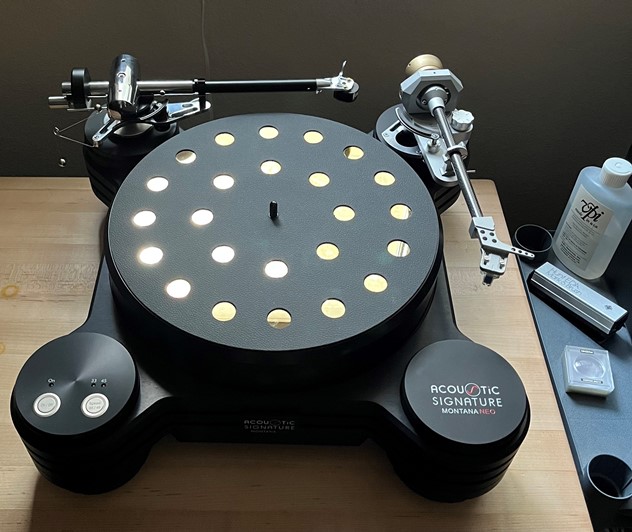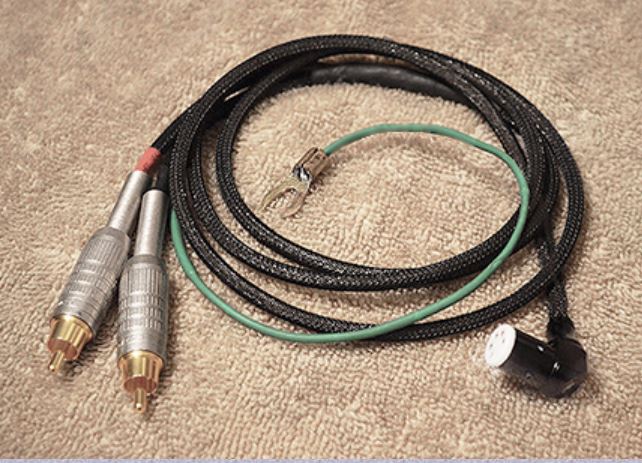Stager Sound Systems is a New York company founded in 1986. They rent and sell pro gear for small to medium-large concerts and special events. There is also a “division” that specializes in interconnect and speaker cables called Stager Silver Solids. As you might guess from the name, these audio cables are made from silver which is 99.9% pure, soft temper, 24 gauge solid core silver wire. Marc Stager started making interconnect cables 26 years ago.
The model under review today is the DIN-RCA phono cable which has remarkably low capacitance, only 11 pF per foot. The insulation is PTFE (Teflon) and the cable sports Cardas DIN and Canare F-10 RCA connectors. Cardas Quad Eutectic solder is used during assembly, and Caig DeOxit Gold is applied to the connectors for tarnish protection and to enhance the electrical connection.
The Silver Solids cable was auditioned with the help of one turntable, two tonearms, and three moving-coil phono cartridges. An Acoustic Signature Montana Neo turntable supported both an Acoustic Signature TA-7000 Neo tonearm and an Origin Live Agile tonearm. The Agile was recently updated to the latest spec. The cartridges included a ZYX UNIverse Optimum (1 Ohm, .15 mV), a Tzar DST and a Koetsu Rosewood Signature Platinum. All combinations enjoyed both the voltage-amplifying and the current-amplifying inputs on a CH Precision P1 phono preamplifier with X1 power supply. The Stager Silver Solids cables are thin and flexible, facilitating an easy installation, or in this case, installations.

For comparison, six other phono cables were present during the audition: an Origin Live Silver Hybrid 2 and a Silver Hybrid S2 along with the latest upgraded versions of both Origin Live cables, a nice Mogami prototype we are testing for inclusion on The Market page, and a low cost but nicely made no-name import with silver plated copper wires. The Stager cables are offered at remarkably low prices compared to other manufacturers’ silver-based wires. The Origin Live cables are priced at about $700 and $1500 respectively. The Stager Silver Solids phono cable is $270. A 1 meter RCA-RCA pair of interconnects is $150, which is a shockingly low price for a pure silver interconnect cable.
Marc and I had an interesting email conversation about breaking in phono cables. There are many different approaches to breaking in audio cables. Several years ago, a cable manufacturer suggested that a phono cartridge’s output is so low that the cable will never be fully broken-in. Marc suggested “an interconnect (including phono) cable should require little or no break-in. It should be entirely satisfactory from its first use, and if there is any change, it should be barely perceptible. Long break in periods are more often than not a manufacturer’s way of getting you used to the sonic signature of their cable. Stager Silver Solids have no particulate “sound”. They just pass signal as accurately as possible and the music is not colored it in any way. So – No break in necessary.”
I posit a function called Volt-Hours. A “standard” 100 hour break-in at line level 2 Volts would result in a 200 Volt-Hours break-in (2 Volts x 100 hours). To reach that same 200 Volt-Hours threshold with a 0.5 mV output phono cartridge would require 200,000 hours of actual playing time. That’s a LOT of retips! I used a cable cooker/sweep sine wave generator for 100 hours at 7 Volts. Using complex modern mathematics (which only 37% of high school graduates are able to comprehend), this translates to 700 Volt-Hours. Done deal.
All good cables, this one included, present the bass and midrange well. But where they often show a weakness is in the treble. This frequency range demands perfect linearity both across the frequency range and also in resolution to present a unified, coherent, and natural sound. The proper reproduction of upper frequency information and harmonics is crucial to the listening experience. The degree of resolution can often be judged as a musical note, or cymbal/bell/triangle, etc., fades into silence. The longer the fade out, the higher the resolution.
Upon first listen, this cable is quickly recognized as being underpriced for the level of performance it brings to a recording. Specifically, the upper midrange and treble is so pure, delicate and refined that informative comparisons to far more expensive cables are possible. The obvious purity of the upper frequency range is world-class. The lower frequencies are also delivered with outstanding resolution.
Brass instruments have their characteristic burnished metal sound, and cymbals – a torture test of the treble frequency range – sound very clear and unambiguous, never offering the dreaded white-noise-like muddled garbage. The upper frequencies are clear and continuous to beyond hearing. Snare drums are wonderfully distinct and true sounding with seemingly unlimited detail and startling believability.
The soundstage is very deep and nicely layered. Left-to-right spread is wide with excellent image placement. A lead singer is typically locked dead-center on the virtual stage. Singers have very good body and depth and are not presented as flat, poster images of the people singing.
A particularly revealing cut, among the repertoire of even better reference recordings, listen to “Switchblade Knife” on the Dire Straits LP. There is microscopic resolution in each easily heard instrument and in Mark Knopfler’s vocals. Bass instruments have powerful impact with a clean leading edge and plenty of punch and energy. Compelling! The bass is perfectly presented: deep and taut. Does “deep” mean that the bass has a reach that is very extended into the lowest bass, or is it rich in tone and resolution? Both!
Knopfler’s vocals on “Wild West End” sound perfect, as if we are in the recording studio. The sound is both pure and direct, putting the listener in the same room as the singer. These observations were using the Koetsu cartridge into one of the current-input connections on the phono stage. So far, the current-input on this phono preamp always sounds better than the voltage-input. Although this LP is a processed studio recording, the dynamics and tone provide worthwhile comparisons between components, including cables.
The Silver Solids cable performed a bit differently than the other cables and is an excellent pairing with the Koetsu Rosewood Signature Platinum cartridge. The combination seems to gain a tiny degree of extra resolution in the bass, while the upper frequencies gain a special clarity and transparency. The latter helps to make vocals more clearly understood, with a nimbler sound overall.

This character is readily identifiable, although subtle. The Koetsu has a warm and rich midrange and while the treble is nicely detailed and present, the upper frequencies sound relatively laid back or not as prominent as the treble from either the Tzar or ZYX cartridges. In other words, turn down the midrange just a bit and turn up the treble and the Koetsu has more of a similar overall balance to these other two cartridges. That’s what the Silver Solids cable does with the Koetsu cartridge, making this very musical cartridge sound somewhat more modern, but without losing the well-known Koetsu midrange magic. This character of the cable is never a problem and results in musical performances that are wholly satisfactory.
Compared to the Origin Live cables, their Silver Hybrid S2 has more presence in the lower midrange and is not quite as open and airy feeling as the Stager cable is, but seems more neutral, overall. The OL cables were preferred when paired with the Tzar or ZYX cartridges with their state-of-the-art treble ranges, while the Stager-Koetsu combination is a match made in heaven. This cable would probably be a terrific partner with any of non-platinum Koetsu cartridges, too. These are small differences between the different cables, for sure, not better or worse, but should inform the issue of system matching.
This is a very refined sounding cable, never harsh or grainy or coarse or abrasive. The sound is wonderfully rich and detailed with natural resolution, far towards the frequency extremes. Into the pool of “10 LP” rated cables, the Stager Silver Solid dips more than just a toe. This cable provides a very clear window for the tiny electrical signals from a phono cartridge. Try a Stager Silver Solids interconnect before they realize how good this cable is and raise the price. A 30-day money-back guarantee awaits.
Overall Rating: 9.5 LPs
Link to manufacturer: Stager Silver Solids

